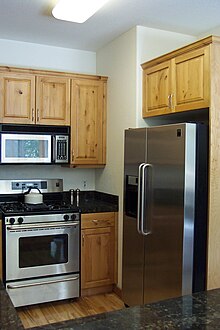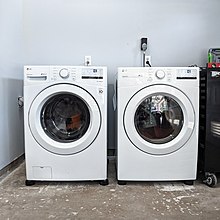Domestic technology
This article includes a improve this article by introducing more precise citations. (January 2022) ) |

Domestic technology is the incorporation of applied science into the home. There are multiple aspects of domestic technology. On one level, there are home appliances, home automation and other devices commonly used in the home, such as clothes dryers and washing machines.
On another level, domestic technology recognizes the use of applied science to construct homes to achieve a particular goal, such as
Types of domestic technology
Many technologies are now routinely used around the home. For example, microwave ovens and washing machines,[2] among others.
Cleaning equipment

Electric lighting
- Fluorescent light bulb

- LED light bulb
Cooking appliances
- Barbecue
- Bread maker
- Blender
- Coffee machine
- Faucet
- Food processor
- Microwave oven
- Mixer
- Oven
- Rotimatic
Food storage and preservation
Home maintenance
- Groundskeeping equipment
- Garden tools
- Paint sprayer
Air conditioning
- Air conditioner
- Central heating unit
- Fan
Computer systems
- Data storage device
- Personal computer
- Telephone
- Video game console
- Knitting machine
- Plumbing
- Home router
Power generation
- Solar panels
- Wind Turbines
Home security
- Surveillance cameras
- Alarm systems
- Electronic locks
Home automation
In the 21st century, especially by the 2010s, home automation has increasingly[3] been introduced into the modern household, colloquially referred to as smart home technology.
While the technology was already in development in the 1990s,
Since modern home networks often make use of wireless networking (e.g. Wi-Fi), modern automation can easily be set up without having to run wires through the building. Alternatively, they can be connected to wired networks.
Types of home automation

- Smart home appliances
- Automatic vacuum cleaners and other Domestic robots
- Smart locks
- Smart speakers, with voice controlled digital personal assistants.
Concerns towards home automation
Unlike older forms of domestic technology, smart appliances are Internet-facing, and there have been many concerns that
See also
- Air quality
- Food safety
- Home automation
- Major appliance
- Water quality
References
- PMID 15383094.
- ^ "New technologies in washing machine smartphone Apps". Edmonton Maple Leaf Appliance Repair. 7 March 2022. Retrieved 24 March 2022.
- ^ "The Rise of the Smart Home, Apartment or Condominium". 30 August 2019.
- ^ "The History of Smart Homes".
- ^ "IoT botnets: Smart homes ripe for a new type of cyberattack".
Further reading
- ISBN 0-465-04731-9.
- Habib, Laurence. Computers and the Family: A Study of Technology in the Domestic Sphere. PhD Thesis, London, UK: London School of Economics and Political Sciences (LSE) 2000 (PDF file).
- Siddiqui, Shakeel, and Darach Turley (2006). "Media technologies: Mediated families" In: Gavan Fitzsimons and Vicki Morwitz ed. Advances in Consumer Research, Vol. 34, Association for Consumer Research: Orlando.
External links
- ICS 97.040.30 Domestic refrigerating appliances Archived 28 February 2007 at the Wayback Machine
- Plan website
